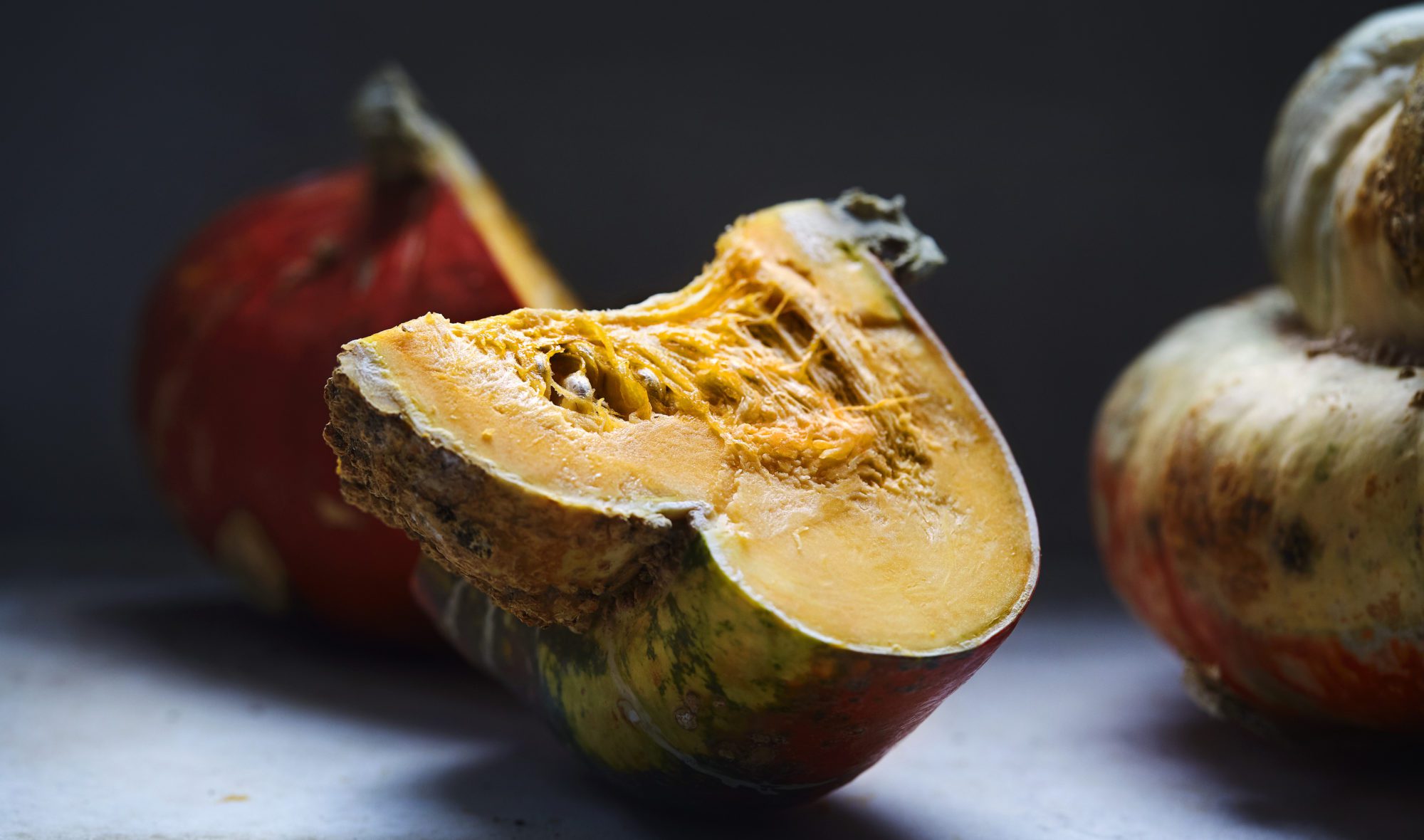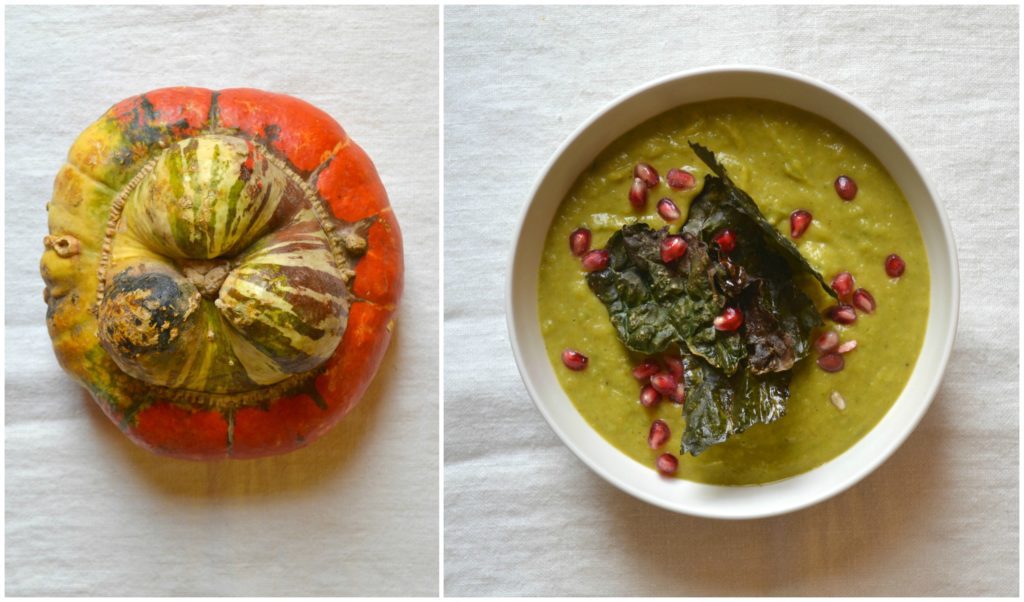
The turban squash is named after the charming turban-like protrusion that appears to sit on the top end of the vegetable like a cap. Due to its flamboyant appearance, this squash is often used for ornamental purposes, but it should not be forgotten as a delicious edible. The pale yellow flesh of the turban squash has a lovely mild and slightly nutty flavor with a soft, floury texture. Like most winter squash, turban squash is high in beta-carotene, which is what gives its insides its golden color. The turban squash makes a delightful guest at the dinner table, both as a dish, and as a centerpiece.
Turban squash is one of the few vegetables that could hold its own as a fascinator hat at a fancy British wedding.
The turban squash is named after the charming turban-like protrusion that appears to sit on the top end of the vegetable like a cap. The squash is also sometimes called Turk’s turban or French turban.
This ornamental (and also edible) winter squash belongs to the Curcubita maxima family, which also includes kabocha, buttercup, and Hubbard squash varieties.
The existence of turban squash is first documented in the early 1800’s in a French horticultural almanac, Le Bon Jardinier. At that time, the flavor of the turban squash was described as bland and watery and better suited for decoration than eating.
Since then, turban squash has been crossbred with Hubbard and acorn squashes to produce the fleshier, more flavorful version that it is today.
Turban squash is a larger variety of squash. It tends to range in size from ten to 15 inches in diameter, and weigh about six pounds.
It has a rather fancy, ornamental appearance, mostly owing to the blossoming protrusion that sits atop the main body of the squash, much like a turban would sit on a head. Turban squash has a deep orange base color with a mottling of yellow, white, and dark green splotches and striations.
The flesh inside is pale yellow, and less vivid both in color and flavor than many other winter squash varieties. The flavor of turban squash is mild and slightly nutty, with a soft, floury texture.
Even after it is cooked, the skin will remain tough, and therefore is usually discarded.
One cup of cubed, baked turban squash (about 205g) has 76 calories, 1.8g of protein, 0.7g of fat, 18.1g of carbohydrates, 5.7g of fiber, and 6.8g of sugar. Turban squash is an excellent source of potassium and vitamin A, in the form of beta-carotene.
The peak season for turban squash is between early fall and winter, but even when in season, you may only rarely find them at larger grocery stores, fruit and vegetable stores, and farmers’ markets.
Therefore, if you do have the opportunity to get a turban squash, scoop it up!
When selecting your squash, choose ones that are heavy for their size, with firm, matte skin that is free of soft spots or cracks. It is common for turban squash to host a few blemishes; these greyish, scaly lumps are completely benign. Since you won’t be eating the skin anyway, just leave them on.
The shape or color variation of turban squash is not an indication of its quality, so choose the wildest and wackiest one you can find.
Uncooked and whole, turban squash will keep at room temperature for about a month. The cap of the squash is the most likely place to show rot first, so watch it carefully.
Once cut, raw turban squash may be kept in the fridge in an airtight container for up to a week.
Once cooked, it may be kept in the fridge in an airtight container for up to a week, or in the freezer for up to six months.
The bad news is: There is no easy way to cut a turban squash.
However, fret not. With a sharp knife and a bit of muscle, turban squash eating is within reach.
Perhaps the easiest way to disassemble and prepare a turban squash is to first chop off the cap or “turban” part of the squash. Once it is decapitated from its body, cut this cap in half, scoop out the seeds and pulp, and set these pieces aside. Then, cut the body of the turban squash in half. It will be slightly easier to cut across with the cap cut off. Then, scoop the seeds and pulp out of these two halves as well. At this point, you can either roast these large chunks in the oven, or trim off the skin (which remains tough after cooking), and cut the flesh into smaller pieces. Either way, drizzle the chunks with some olive oil and sprinkle with salt, and bake in a 400 degree Fharenheit oven for 30-60 minutes, depending on the size of the chunks. The squash will be done when it has turned golden brown at the edges and can be pierced with a fork easily.

This pureed soup is smooth, creamy, and satisfying, with flavor coming from layers of warming spices. Kale chips and pomegranate arils add crunch and pops of sweetness.
Prep Time: 15 minutes Cook Time: 90 minutes Yield: 4-6 servings
For the soup:
First, prepare your squash: Cut around the “cap” of the turban squash, like you would cut around the top of a jack-o-lantern. Scoop out the seeds and pulp from both the “cap” and the main body. Cut these two pieces into approximately six large wedges. Place these wedges on a baking tray, drizzle with olive oil, sprinkle with salt, and place in a 400 degree Fharenheit oven. Bake for 45-60 minutes, or until squash flesh is soft and browning at the edges. Allow to cool slightly, and then scoop the cooked flesh away from the hard skin. Discard the skin; reserve the flesh.
While your squash is baking, cook the leeks. Add butter to a large pan over medium-high heat and bring to a sizzle. Add leeks and salt, and cook until soft, about 10 minutes. Add coconut milk and spices, and cook further for another five minutes or so.
Once squash and leeks are both cooked, add them, plus the broth, to a blender or food processor. Alternatively, this can be done in a big pot with an immersion blender. Process until smooth.
If you have purchased a pomegranate, cut it open and pop out the seeds for garnish.
Serve the soup into individual bowls, and top with kale chips and pomegranate, or your choice of toppings (toasted pumpkin seeds, fresh sage, and dried currants are nice too). Serve hot.
For the kale chips:
Wash the kale, then dry it thoroughly. Remove the leaf portion from the coarse stem, and reserve the leaves. You can use the stems for juicing, smoothies, or other recipes.
In a large bowl, add leaves, olive oil, and salt. Toss until all leaves are coated with oil and salt.
On a parchment-lined baking tray, lay the kale leaves out, being careful not to overlap the leaves. If the kale is too cramped on the tray, they will not get crispy. You will likely need two pans.
Place the trays of dressed kale leaves in a 350 degree Fharenhiet oven, and bake for 10-12 minutes. Remove them from the oven, flip the leaves, and then bake for another five minutes or so. Watch them carefully so they don’t burn. When they are done, the kale leaves will be brown in some places but will still be mostly green, and wonderfully crispy.
Precision Nutrition’s Encyclopedia of Food expands every single month as we highlight new foods and showcase beautiful food photography. If you’d like to stay up to date, simply click this link. From there, we’ll send you a FREE copy of our recipe book. We’ll also let you know when new and delicious foods are added to the site.
The turban squash is named after the charming turban-like protrusion that appears to sit on the top end of the vegetable like a cap. Due to its flamboyant appearance, this squash is often used for ornamental purposes, but it should not be forgotten as a delicious edible. The pale yellow flesh of the turban squash has a lovely mild and slightly nutty flavor with a soft, floury texture. Like most winter squash, turban squash is high in beta-carotene, which is what gives its insides its golden color. The turban squash makes a delightful guest at the dinner table, both as a dish, and as a centerpiece.